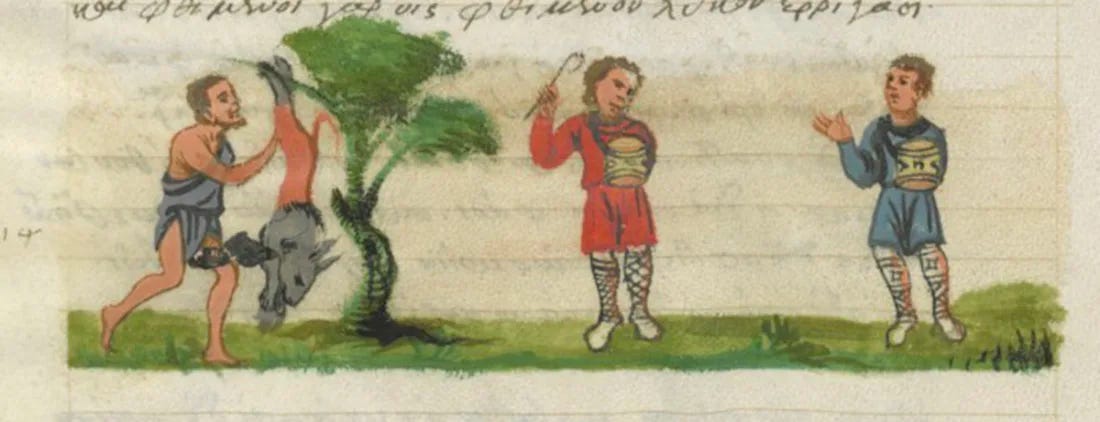I first encountered the djembe a few months ago, when another percussionist at school taught me some rhythm patterns and playing techniques. I remember feeling intrigued by the fact that a single drum could create so many different pitches and textures of sound. I was curious to find out more and began to research and learn more about this instrument and its history.
The djembe is a West African drum, which is thought to date back to 1200 AD in the Malian Empire.1 It belongs to the membranophone category of percussion instruments which, as the name suggests, produce sounds through vibrations created when membranes, usually made from animal skins or synthetic materials, are stretched and struck by hands or sticks.2 In rare instances, friction is used to produce sound on membranophones, as in the case of the cuíca—a Brazilian instrument that requires the performer to rub a damp cloth against a stick that is attached to the inside of the membrane.3 Surprisingly, membranophones can also be sung or hummed into; for example, the kazoo requires its player to blow air through a cylindrical chamber onto a membrane inside, which creates a buzzing sound.4 Although modern readers may be familiar with more popular membranophones such as the timpani, tambourines and snare drums, this category of instrument is wider than commonly thought and spans across many centuries.
Figure 1: Manuscript illumination by Bartolomeo Zanetti from “Cynégétiques du pseudo-Oppien” (1501-1550).
The djembe is one of the most ancient membranophones known to human beings today and its range of sound is more ample than an unpitched drum. In fact, there are three pitches that can be produced by the djembe: the bass, the tone and the slap (figure 2). The bass is the lowest pitch that can be played on the djembe, and requires the musician to strike the centre of the drum, which is the most hollowed out region, with a flat and relaxed palm. Although it is often said that this is the most straightforward sound to create out of the three pitches, it is deceptively difficult, as the speed of the motion needs to be controlled in order to produce the right sound. As one instruction manual puts it, “your hand only needs to touch the drum for a moment and needs to bounce off the drum as quick as it hit it.”5
Figure 2: Hand placement for different pitches indicated on the membrane of a djembe.
Secondly, the tone, which is the middle register, is played by the pads beneath the fingers or the top of the palm strike near the rim of the djembe. The same instruction manual advises players to “keep your hands relaxed” but “your fingers off the skin [of the drum].”6 The tone sound is produced by the wood of the djembe shell, so performers should also aim to strike into the wood of the instrument. Finally, the highest pitch that can be played on the djembe is the slap, for which manuals advise aspiring performers to completely relax their fingers and hit the rim of the drum. This creates a “high-attack slap sound,” which can be easily distinguished from the tone, which is lower in pitch.7
Although it may seem quite straightforward to play, with only three pitches, learning the djembe can take up to a lifetime.8 This is what makes the instrument so fascinating and paradoxical: the simple appearance of the djembe belies the complexity of the drum and the nuanced methods of playing that it requires. It is commonly misunderstood that percussion instruments are not as challenging as those belonging to other genres of music, like strings or woodwind instruments; however, many such instruments, and pitched membranophones in particular, require extensive skill and practice.
Iconic masters of the djembe include Famoudou Konaté, Mamady Keïta, Ladji Camara and Babatunde Olatunji, among numerous others highly skilled players. The video below shows Konaté and Keïta joyfully playing together to a small audience in Matoto, Guinea, in January 2000.
Finally, the name of the djembe originates from Mali in West Africa, where the native language is Bambara. Specifically, the word “djembe” is thought to derive from the Bambara saying “anke djé, anke bé,” which translates to “everyone gather together in peace.”9 This clarifies the drum’s purpose of uniting communities and bringing about peace. It also suggests that the drum is far more than just an instrument for entertainment, but holds an important place in the social history and practices of local communities.
Alan Tauber, “History of The Djembe,” The Drum Connection - Boston’s Drumming Community, 2015, https://www.drumconnection.com/africa-connections/history-of-the-djembe/, accessed 14 August 2023.
“Echos of an Empire - Membranophones,” Europeana, https://www.europeana.eu/en/exhibitions/byzantine-musical-instruments/membranophones, accessed 14 August 2023.
Hannah Gee, “Membranophone Instrument List,” Orchestra Central, 27 June 2022, https://www.orchestracentral.com/membranophone-instruments-list/, accessed 14 August 2023.
Ibid.
“How to Play Djembe - The Three Sounds,” Rhythm Culture, 4 May 2015, https://rhythmculture.com.au/how-to-play-djembe/, Accessed 7 August 2023.
Ibid.
Ibid.
“How to Play Djembe - Start Here,” Afrodrumming, https://afrodrumming.com/djembe-101/#:~:text=EVEN%20WHEN%20YOU'RE%20PRACTICING,djembe%20can%20take%20a%20lifetime, Accessed 21 August 2023
Abdoul Doumbia & Matthew Wirzbicki, Anke Djé Anke Bé: Djembe and Dounou Music from Mali, West Africa, Vol. 1, 3idesign, 2005, p.86. Print.



